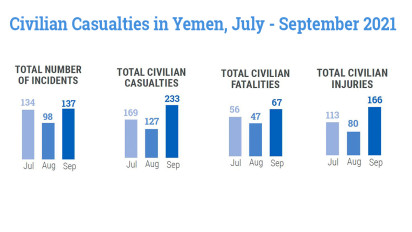
Civilians faced with rising violence in Yemen
The civilian population in Yemen continues to bear the brunt of the conflict, which is now in its seventh year. Escalations in military hostilities, clashes between rival armed groups, and pervasive unexploded remnants of war (ERW) and improvised explosive devices (IED) are causing the death and injury of children, women and men across Yemen, and disrupting lives and livelihoods. In a briefing on 19 October, UNICEF noted that 10,000 children have been killed in Yemen since March 2015 – equivalent to four children each day – while many more child deaths and injuries are unrecorded.
Armed violence resulted in 529 civilian casualties in Yemen during the third quarter of 2021, according to the latest Civilian Impact Monitoring Project (CIMP) quarterly report . These are a direct result of armed violence between July and September, and include 170 civilian fatalities and 359 civilian injuries. The third quarter civilian casualties included 70 children and 41 women. 4 The highest monthly civilian casualty count during the third quarter was in September, when 233 civilian casualties were reported, including 67 civilian fatalities, the second highest monthly totals in each case this year. This is an average of nearly eight civilian casualties per day in September – the second highest figure in two years. In the third quarter, Small Arms Fire (SAF) was responsible for 203 civilian casualties, including 93 fatalities, up from 148 during the second quarter in 2021. Cross border hostilities resulted in Sa’dah Governorate seeing more civilian casualties than any other governorate with some 136 civilian casualties reported in the third quarter, including 38 civilian fatalities.
Remnant explosive ordnances caused the greatest toll among children over the third quarter. Armed violence resulted in 70 casualties among children in the last quarter, including 17 fatalities. This marks a decrease from 121 child casualties during the second quarter. Remnant explosive ordnances, including landmines and UXO, collectively resulted in 61 per cent of the 43 child casualties reported during the third quarter: almost two thirds. Almost half of these child casualties -18- were reported in Al Hodeidah. Lack of risk awareness due to lack of funding, coupled with heightened inquisitiveness and increased mobility, including in more remote areas that may not have seen clearance efforts, drive the vulnerability of children to harm from remnant explosive ordnances. The Yemen Executive Mine Action Center (YEMAC) clears an average of 3 million square meters per year in Yemen, benefiting an average of 3 million people per annum – 2 million through mine clearance and surveys and a million via explosive ordnances risk education (EORE). Yet clearing alone is not enough, especially as hostilities persist. Humanitarian partners continue to call on parties to the conflict to uphold the obligations under international humanitarian and human rights law to take all necessary measures to protect civilians and to exercise caution, including by refraining from using explosive weapons and landmines in densely populated areas.